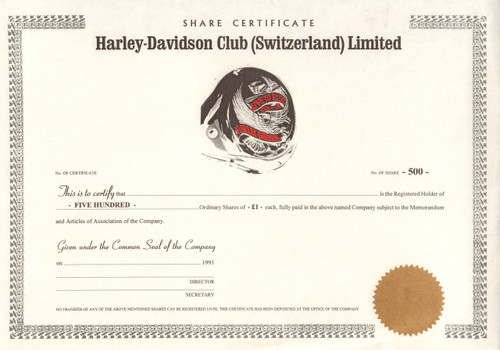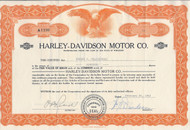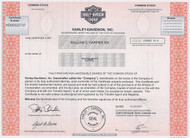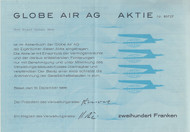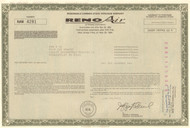Categories
Categories
- Home
- Automotive
- Motorcycle
- Harley-Davidson Club (Switzerland) Limited 1993
Harley-Davidson Club (Switzerland) Limited 1993
Product Description
Harley-Davidson Club (Switzerland) Limited share certificate 1993
Harley Davidson motorcycles are popular everywhere in the world as evidenced by this Swiss share certificate for a HOG club. Great stylized vignette of the Live to Ride logo. Unissued but printed dated 1993. Excellent gift idea for the Harley rider and collector.
Harley-Davidson Motor Company, the only major U.S.-based motorcycle manufacturer, produces heavyweight motorcycles and a complete line of motorcycle parts and accessories and general merchandise.
Founded in Milwaukee, Wisconsin, during the first decade of the 20th century, it was one of two major American motorcycle manufacturers (Indian being the other) to survive the Great Depression. Harley-Davidson also survived a period of poor quality control and competition from Japanese manufacturers.
From 1977 to 2014 the only motorcycles sold to the public under the Harley-Davidson brand were heavyweight cruiser motorcycles, with engine displacements greater than 700 cc. Harley-Davidson motorcycles, or "Harleys", are noted for the tradition of heavy customization that gave rise to the chopper style of motorcycle.
In 1901, 20 year-old William S. Harley drew up plans for a small engine, designed for use in a regular pedal-bicycle frame. Over the next two years, Harley and his childhood friend Arthur Davidson worked on their motor-bicycle using the north side Milwaukee machine shop at the home of their friend, Henry Melk. It was finished in 1903 with the help of Arthur's brother, Walter Davidson. Upon testing their power-cycle, Harley and the Davidson brothers found it unable to climb the hills around Milwaukee without pedal assistance. They quickly wrote off their first motor-bicycle as a valuable learning experiment.
Work immediately began on a new and improved second-generation machine. This first "real" Harley-Davidson motorcycle had a bigger engine. The machine's advanced loop-frame pattern was similar to the 1903 Milwaukee Merkel motorcycle. The bigger engine and loop-frame design took it out of the motorized bicycle category and marked the path to future motorcycle designs. The boys also received help with their bigger engine from outboard motor pioneer Ole Evinrude, who was then building gas engines of his own design for automotive use on Milwaukee's Lake Street.
The prototype of the new loop-frame Harley-Davidson was assembled in a shed in the Davidson family backyard. Most of the major parts, however, were made elsewhere, including some probably fabricated at the West Milwaukee rail shops where oldest brother William A. Davidson was then toolr oom foreman. This prototype machine was functional by September 8, 1904, when it competed in a Milwaukee motorcycle race held at State Fair Park. It was ridden by Edward Hildebrand and placed fourth. This is the first documented appearance of a Harley-Davidson motorcycle in the historical record.
In January 1905, small advertisements were placed in the Automobile and Cycle Trade Journal offering bare Harley-Davidson engines to the do-it-yourself trade. By April, complete motorcycles were in production on a very limited basis. That year, the first Harley-Davidson dealer, Carl H. Lang of Chicago, sold three bikes from the five built in the Davidson backyard shed. In 1906, Harley and the Davidson brothers built their first factory on Chestnut Street (later Juneau Avenue), at the current location of Harley-Davidson's corporate headquarters. The company produced about 50 motorcycles that year.
In 1917, the United States entered World War I and the military demanded motorcycles for the war effort. Harleys had already been used by the military in the Pancho Villa Expedition but World War I was the first time the motorcycle had been adopted for combat service. The U.S. military purchased over 15,000 motorcycles from Harley Davidson during World War I. By 1920, Harley-Davidson was the largest motorcycle manufacturer in the world, with 28,189 machines produced, and dealers in 67 countries.
Harley-Davidson launched a line of bicycles in 1917 in hopes of recruiting customers for its motorcycles. Besides the traditional diamond frame men's bicycle, models included a step-through frame 3-18 "Ladies Standard" and a 5-17 "Boy Scout" for youth. The effort was discontinued in 1923 because of disappointing sales.
One of only two American cycle manufacturers to survive the Great Depression, Harley-Davidson again produced large numbers of motorcycles for the US Army in World War II and resumed civilian production afterwards, producing a range of large V-twin motorcycles that were successful both on racetracks and for private buyers.
In 1969, American Machine and Foundry (AMF) bought the company, streamlined production, and slashed the workforce. This tactic resulted in a labor strike and lower-quality bikes. The bikes were expensive and inferior in performance, handling, and quality to Japanese motorcycles. Sales and quality declined, and the company almost went bankrupt. The "Harley-Davidson" name was mocked as "Hardly Ableson", "Hardly Driveable," and "Hogly Ferguson",and the nickname "Hog" became pejorative. In 1981, AMF sold the company to a group of 13 investors led by Vaughn Beals and Willie G. Davidson for $80 million.
.
 Loading... Please wait...
Loading... Please wait... 
